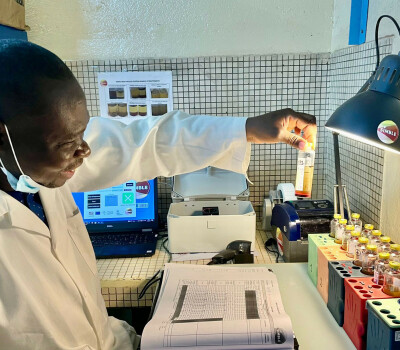The wonderful world of worms
Idzi’s enthusiasm about parasites is truly infectious. When he wants to illustrate a story, he jumps up and grabs one of his “samples” from the closet that are peacefully floating around in formaldehyde. To some, he has even given names. Idzi Potters started his career at ITM 25 years ago, and has been actively involved in the diagnosis of parasitic infections in our clinical reference laboratory. He trains dozens of professionals in ITM’s postgraduate and master’s courses every year and has given parasitology courses to medical students at the University of Antwerp. He has published several scientific articles on peculiar cases, and he is an avid photographer of his “creepy critters”. Most recently, he authored the "Reagents, Stains and Media: Parasitology" chapter in the textbook "Manual of Clinical Microbiology - 13th Edition".
What prompted you to work with parasites? Some parasitologists seem to have very personal stories…
So do I (laughs)! My grandmother ate a portion of steak tartare in the 1980s, which turned out to give her a tapeworm infection. Current treatments now work differently, but in those days the tapeworm left the body as a whole after the patient took the medication. As it was standard procedure, my grandma was asked to bring the worm to a lab for examination – it needed to be proven that the whole worm exited, because if the head were to remain in the intestines, the entire worm would simply grow back in no time. So she collected this massive worm in a very big jar, and 10-year-old me was just fascinated. I was also very jealous seeing how proudly she paraded around with it (laughs). This incident left a lasting impression on me and may have played into my career choice.

Which parasite do you find most peculiar?
Strongyloides stercoralis, which is a small, parasitic roundworm. They have some amazing qualities! First of all, they are capable of so-called auto-infection: their eggs are laid in the intestine, hatch there, and while most of the resulting larvae will be excreted in the stool, some may mature and immediately re-infect the same host either by burrowing into the intestinal wall, or by penetrating the skin around the anus. This incredible characteristic means that without treatment, persons may remain infected throughout their lifetime. For immunocompromised individuals, this feature can prove to be fatal. Secondly, you can only get infected with females. Inside a host, these females are able to reproduce alone. Thirdly, once outside of their host, the larvae can decide to develop into adult males and females and go through a complete sexual reproduction cycle in the outside environment – another feature that is quite unique for a parasite!
S. stercoralis infections are associated with fecal contamination of soil or water, so basically walking barefoot in infested mud. In Belgium it used to be present within the mining industry, but it is not anymore. It is most commonly found in areas with tropical and subtropical climates.

You work in ITM’s Clinical Reference Laboratory, so samples from patients from our travel clinic will end up under your lens. What parasite do you find most often in returning travellers?
Not much anymore – there were better days (laughs)! In the older days, travellers or missionaries brought entire zoos with themselves. We have also often found parasites in children who were adopted from low-income countries. Nowadays we find much less parasites: travellers are better informed of the risks and they are more careful, hygiene improved in many places, and regulations concerning food, water and travelling are stricter.
Three years ago we published a paper on a very unusual case. A 31-year-old male patient, native of Sierra Leone, who had not travelled outside Europe after migrating 20 years ago, presented to the emergency department with acute slightly bloody diarrhoea, abdominal pain and vomiting. At an intestinal biopsy the lab found Schistosoma eggs. Schistosoma mansoni is a water-borne parasite which causes intestinal schistosomiasis or “snail fever”, a neglected tropical disease. Although it is not uncommon to find eggs of this parasite even several years after successful treatment, these eggs would no longer be viable. Since the modern techniques where we use ether for concentrating parasite eggs would kill them, I needed to look for an alternative solution. After digging in the literature I stumbled upon the long-forgotten glycerol sedimentation method, and with that I was able to determine that the eggs were still very much alive. Imagine: these worms were not only still alive in his body after two decades, but were still producing eggs!

Which is the most common parasitic worm in Belgium?
Probably the pinworm (Enterobius vermicularis). In fact, pinworms are a strong exception to the tenet that intestinal parasites are uncommon in high-income communities. The pinworm has a worldwide distribution, and they are particularly common in children under 10. The adult worms are small, under 1cm. Female pinworms are able to produce 16,000 eggs which they deposit at the rectum, and by scratching, the host spreads them all over their environment. So it is very easy to get re-infected and infect one’s entire household. Luckily, there is effective treatment available.
For the future, there are some parasites to pay attention to. Dirofilaria repens is a parasite affecting dogs, cats and sometimes accidentally also humans. Due to climate change, the mosquitoes that transmit the parasite are able survive in more Northern regions of Europe; so we can likely expect more of these infections in the future.
The “Manual of Clinical Microbiology” (published by ASM Press) is a 3000-page textbook on infectious agents, diagnostic methods, laboratory techniques, and guidelines, revised by an international team of editors and authors. It is a reference meant for laboratory staff, microbiologists, clinicians, scientists medical fellows and students. It is used in laboratories all around the world. The 13th edition is coming out online chapter by chapter. The hard copy is expected in 2023.
Spread the word! Share this story on










